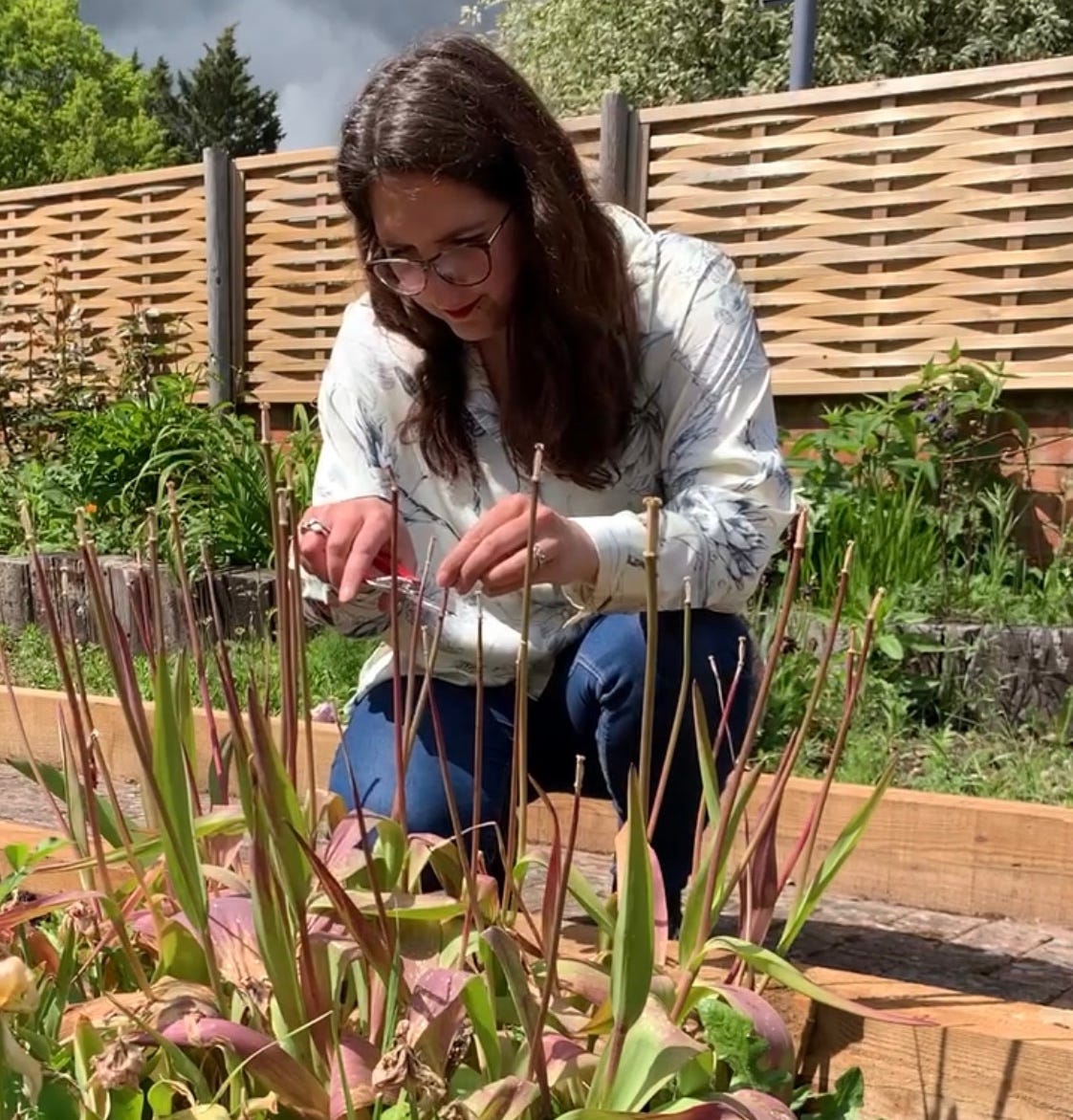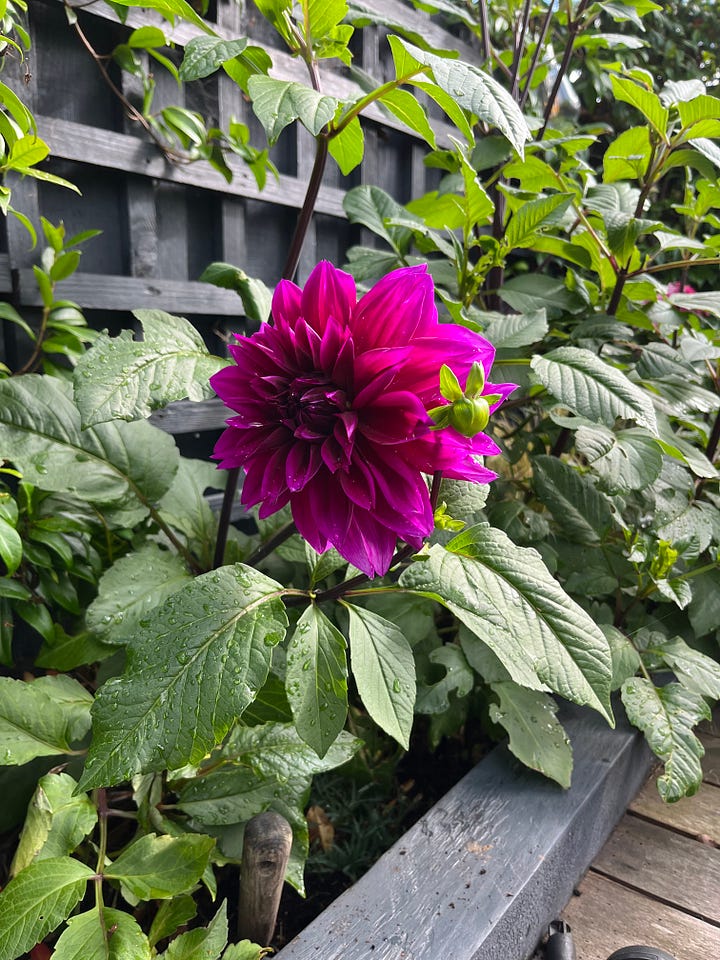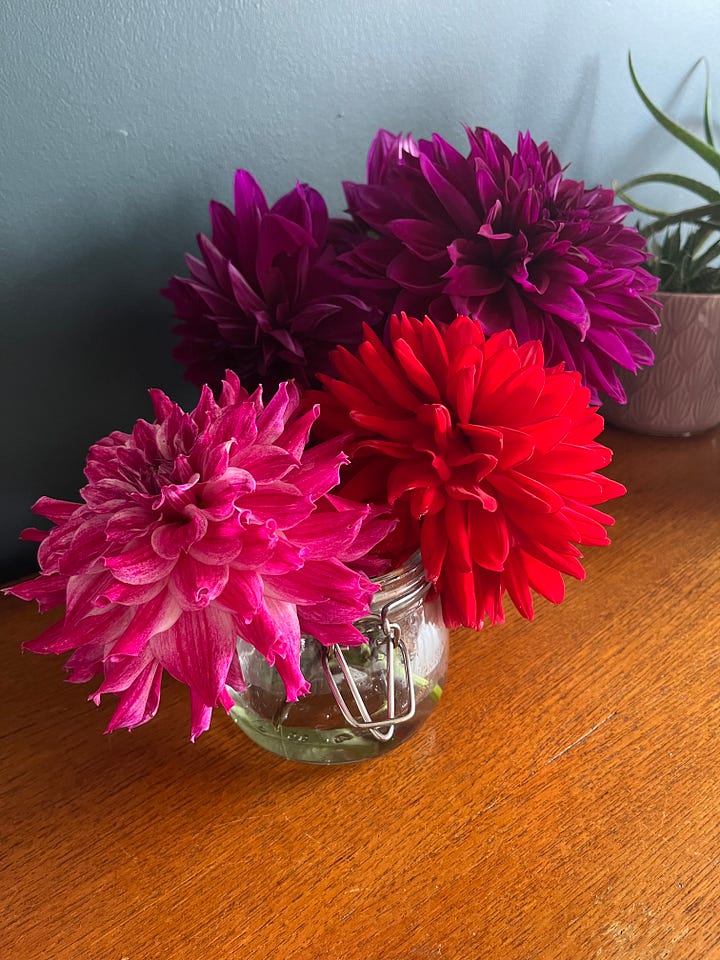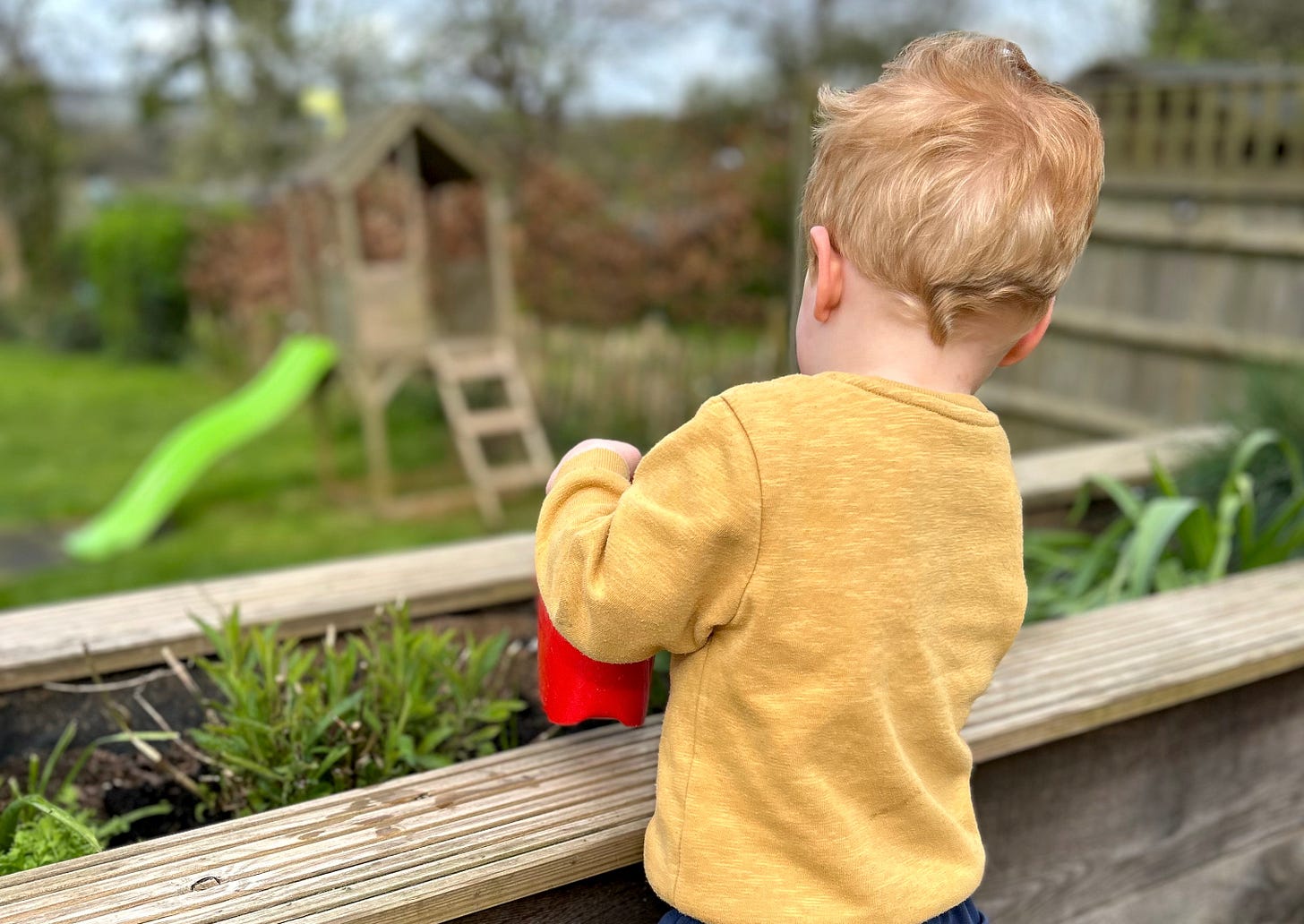How to make your garden a wellbeing sanctuary the whole family can enjoy
This week guest writer and fellow Substacker Kendall Platt reveals how you can transform your garden to boost your family’s wellbeing without adding to the mental load

Would you love for your garden to be a relaxing paradise full of colourful plants and buzzing with life? Do you want to carve out a place where you can go to relax at the end of a long day, laugh with friends or take 10 minutes for yourself with a coffee while the kids hunt for bugs? Then this week’s newsletter is for you!
I appreciate that, for many of us, our gardens are a source of stress. Another thing on the seemingly never-ending to-do list! And while the temptation can be strong to pay a small fortune to get a garden designer to come and do it all for you, I’d like to put it to you that you CAN DO IT YOURSELF, while reaping the benefits to your mind, body and soul that come with connecting with nature. I’ve put together 5 steps for you to follow to create your family's dream outdoor space. Enjoy!
1. Where to start

Summer has finally arrived! And, while the lure of heading straight to the garden centre and doing a supermarket sweep style mad dash for plants increases, there are a couple of steps to go through first to make sure your garden becomes the relaxing haven you’re hoping for.
Start by asking yourself ‘How do I want to feel when I’m in the garden?’ It might be that you want your garden to help you relax after a full-on day at work or with the kids. Or perhaps you would like it to re-energise you after the third Zoom call of the day? It might be that you’d like it to do both.
A simple way to elicit these feelings is by using colour. For peaceful vibes, choose a simple green and white colour scheme. To help you restore your energy levels choose bright clashing colours such as hot pinks, yellows and oranges. Or if your aim is calm and relaxation, opt for blues and purples to lower your anxiety levels.
If you would like your garden to help you relax, the sound of running water as part of a pond or the feeling of being enveloped by nature by including elements to encourage wildlife such as bug hotels, nesting boxes and hedgehog houses can all help, too!
2. Get to know your garden
Before you decide where any of these garden elements might go you need to tune into your garden. Where does the sun fall throughout the day? Is the perfect spot for a morning coffee in the sun or in full shade in the evening?
Draw a big sketch of your garden (it doesn’t need to be fancy) and, starting at the beginning of the day, head out into the garden and for every area that is in sun draw an ‘S’ on your plan. You can also scribble on whether it’s morning or evening sun. Once the sun goes down, you will have a good idea of your sunny spots (more than 6 ‘S’) and your shady spots (less than 3 ‘S’). This information is going to be gold when you start choosing plants because certain plants prefer shade and others need full sun in order to flower well. So you can match your plants to the conditions you have available for them.
The next thing you need to know is your soil type. Take a trowel and dig up a handful of soil from your garden. Put it into your hand and try and roll it into a sausage. This is a fun one to get the kids involved in. If you can easily roll it into a sausage then you have clay soil. If it slips through your finger then you have sandy soil. And anything in the middle is a loam-based soil, which is made up from small bits of clay, sand and other inclusions such as stones.
A loam-based soil is the easiest to work with as it has good nutrient levels and allows water to drain away from your plants’ roots. Certain types of plants will struggle in clay soil, such as bulbs (TIP: Grow them in a pot) and plants that require a lot of nutrients may struggle in sandy soil.
Mulching and adding organic matter to your soil – regardless of type – each year will help the soil to retain nutrients and feed your plants. Plus it’s a great family workout shovelling on to your borders.
3. Think about how you want to use your space
You don’t have to have a huge garden to create an enjoyable outdoor space for the whole family. Get a big piece of paper and ask everyone in the family to draw or write down ideas for their dream garden and crucially for the kids, what they want to be able to do out there.
Once you have your master list of inspiration you might see that some of these are a little at odds with each other, chill-out zone for you and football pitch for the kids, for example. This is where you can rely heavily on zoning and we can use garden features and plants to help us denote these separate areas.
Armed with your knowledge about the conditions your garden has to offer you can start to decide where big garden features might go. Entertaining area (TIP: this doesn’t need to be right next to the house), veg patch if you’re keen to grow your own, mud kitchen for the kids, a relaxation nook for you and any other growing areas.
Take a moment to think about how you might get between each zone. Some recommended pathway substrates for busy parents are paving and brick pathways. Gravel makes a lovely sound underfoot, it’s cheaper and the kids love to play in it, but you will be forever weeding it – yes even if you use that weed membrane underneath.
4. Planting choices


I highly recommend creating a list of plants to buy before you go to the garden centre. This allows you to make considered purchases that will create a cohesive look in your garden that is pleasing to the eye, and your other senses too.
In a wellbeing garden it’s important that you plant for the senses and so here are some low-maintenance favourites for each sense. I’ve also suggested perennial plants so that they come back each year with little input from you.
Sight - This is the dominant sense for most of us and probably the one that you are used to using when observing gardens. In a world that is obsessed with how things look it can’t be ignored, but try where you can to incorporate plants that delight other senses too. To keep it interesting, choose different shapes of flower throughout the border, some round blooms, some spire-shaped and some flat-topped dome-shaped flowers. Sun-loving Dahlias come in different varieties and pretty much every colour you could imagine, so they’ll fit right into whatever colour scheme you’re going with. Veronica Spicata is great at the front of a sunny border. These spires are loved by the bees and look great in a vase too. Yarrow or Achillea Millefolium are available in white and beautiful rich jewel colours and will happily grow in full sun to partial shade. Their flat-topped flowers are loved by butterflies as they can easily land on top of the flower and drink the nectar.
Sound - Tune into the sound of the bees as they buzz busily round lavender in the sunshine. The seed heads of Spangle grass of Chasmanthium Latifolium will bob gently in the wind and knock together creating a relaxing background sound even in partially shady borders. An Amelanchier tree creates beautiful year-round interest and its winter berries will keep the birds fed and coming back to your garden through all the seasons so you can enjoy their song.
Smell – If you like chocolate then you need to plant Chocolate Cosmos. Their deep red daisy shaped flowers will waft chocolate scent across your garden when planted in full sun. Star Jasmine is perfectly paired to a seating area as its glossy evergreen leaves that have a hint of red in autumn accented by tiny white flowers provide a sweet scent in the evenings. Roses are a wonderful smelling flower but different roses have different scents and enjoy different levels of sun so take a trip to the garden centre and decide which scent creates the vibe you’re going for. Remember they will need pruning once a year but other than that, standard roses require little in the way of maintenance.
Touch - Plant Angel wings in a relaxation zone with full sun. The leaves feel like stroking a puppy’s ear which is great for grounding you quickly after a busy day. Mexican Fleasbane is perfect next to a sunny or partially shady pathway, overspilling down a wall or raised bed, so that as you move through the garden you feel their soft touch as a reminder that your garden is an extension of you. Echinops Ritro have spiky balls loved by the bees and its strangely satisfying to run your fingers over their spikes!
Taste - Create a herb planter on your outdoor entertaining table so guests can select and add fresh herbs to their drinks or salads. Some favourites of mine are hot and spicy oregano and blackcurrant sage. There’s also nothing better than picking a sun-ripened strawberry straight from the plant and popping it into your mouth. Plus each year they’ll create more plants which means more delicious fruit.
Once you have your list of plants, decide how many of each you would like to have in each growing area. Odd numbers are more pleasing to the brain as it has a central plant to focus on when looking at the border. Our brains don't need any more stress so opt for 3, 5 or 7 of each plant type. If you’re on a budget, choose one big plant at the garden centre and split it into 3 before planting.
5. Gardening activities for all
Before you do any of the following activities, notice how you are feeling on a scale of 1-10 before you start. Where 1 is anxious/ stressed/ exhausted and 10 is calm/ relaxed/ energised.
Planting - once you’ve bought your plants it’s time to get them in the ground. Dig a hole twice the size of the pot your plant is in as you focus on the sound of the trowel contacting the soil. Sprinkle some granular plant food such as blood, fish and bone in the base of the planting hole and notice the feeling of the granules slipping through your fingers as you do so. Place your plant in the centre of the hole and backfill with soil. Use your hands to create a moat around the plant and pour water into it to keep the water near its roots.
Weeding – it’s the one activity that can feel like a chore until you make it mindful. As you are weeding, channel any negative thoughts you have swirling around in your head into the weeds. As you unearth the weeds and throw them into your compost bin imagine the negative thoughts that you want to unearth from your mind going with them. This is great to do with the kids, just make sure they’re not digging up any freshly planted plants!
Watering - this is a wonderful exercise to do at the end of a long hot day. As the water contacts the soil, notice the colour change from grey/ brown to almost black as the moisture seeps through the soil. Close your eyes and inhale deeply, that smell, the smell of rain on the hot ground is called petrichor and it’s well regarded as being one of the most grounding scents in nature.
Once you’ve finished the activity check in again with yourself. How are you feeling now on that scale of 1-10? Let us know in the comments below.
We hope you enjoyed this guide and found Kendall’s advice helpful and nourishing! For more weekly mindful gardening activities straight to your inbox, we recommend subscribing to Kendall’s own Substack newsletter The Seed – you won’t be disappointed!






